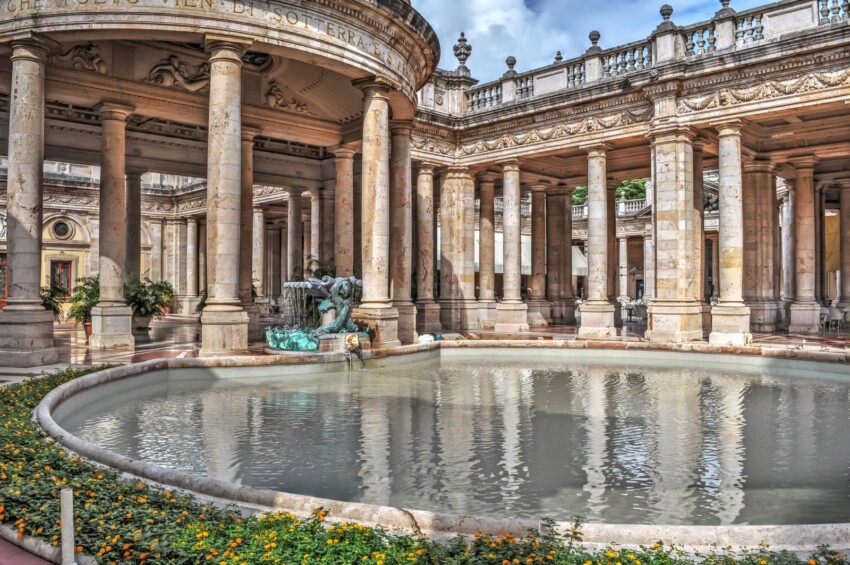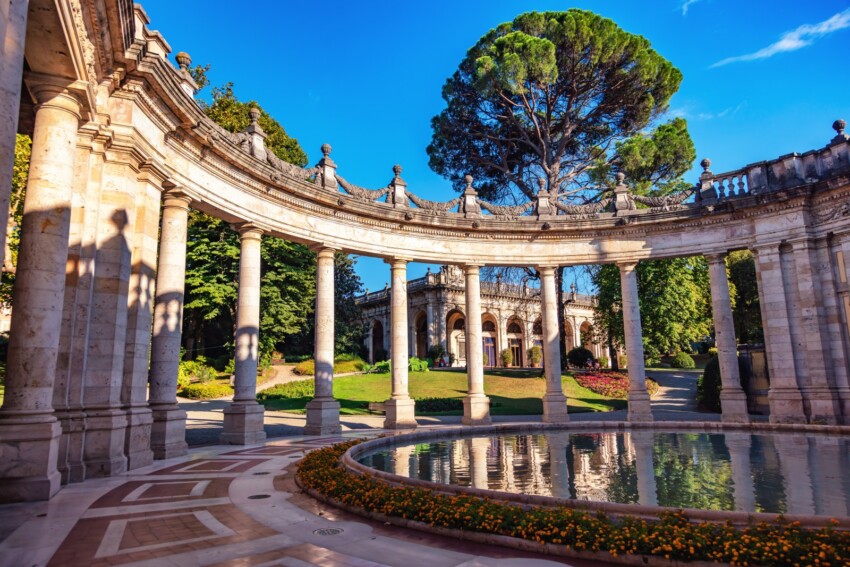

In the province of Pistoia, one of the most interesting tourist destinations is undoubtedly Montecatini Terme. This town of 20,000 inhabitants is in fact a destination that has always been synonymous with tourism, thanks above all to its thermal springs, which already in the 19th century attracted many holidaymakers to the city, including several illustrious personalities such as Giuseppe Verdi, Ruggero Leoncavallo, Giacomo Puccini, and Vittorio Emanuele II. The most important personalities are commemorated on the Walk of Fame along the pavements of Viale Giuseppe Verdi, where circular studs record the main names that visited Montecatini Terme.
Today, Montecatini Terme is protected by UNESCO, being part of the World Heritage Site called the Great Spa Cities of Europe, an indivisible collection of 11 European cities that developed from the Enlightenment to the 20th century. Much of Montecatini’s success is in fact due to its thermal baths, but even if you are not a fan of this kind of thing, the town is definitely worth a visit, thanks to the many things to see, its perfectly maintained historical centre with parks, gardens and Art Nouveau villas, and the possibility of some interesting excursions in the surrounding area.
Last but not least, Montecatini is in a very favourable position with respect to the great attractions of Tuscany: Florence, Pisa, Lucca and Versilia are no more than half an hour away by car. You can therefore arrive in Montecatini Terme and choose it as a base for your stay during your holiday, thanks also to the abundant choice of hotels, the convenience with respect to the motorway and railway, and the generally lower prices compared to large cities.
The thermal bath s of Montecatini have a centuries-old history, the first written mention being on a parchment from Lucca dated 1201. Over the following centuries they acquired fame, so much so that in 1773 the Bagno Regio, the town’s first thermal establishment, was built. The history of Montecatini’s establishments continued until 1962, when the Stabilimento Redi1 was built.
The springs of the thermal bath s are fed by 4 springs that originate at a depth of about 70 metres; as they travel towards the surface, they are enriched with mineral salts and form 4 different waters: the Leopoldina water, the Regina water, the Tettuccio water and the Rinfresco water, each of which is specific for treating distinct problems.
Today, there are 9 thermal establishments in Montecatini, all located at a reasonable distance from the town centre. Among them, the most famous are the Terme Tettuccio2, with its wonderful architecture and extremely scenic interiors based on the concept of the Roman thermal baths. Also interesting are the Terme Excelsior3, located inside the pavilion originally designed to house the Excelsior municipal casino, and of course the Terme Leopoldine4, the oldest in the city, built in 1777 by the Grand Duke of Tuscany Pietro Leopoldo.

The historical centre of Montecatini Terme is compact and can be easily walked around. Here are the best attractions in and around the town, to be visited one by one before a relaxing bath in the spa.
Along Viale Verdi, the building of the municipal palace of Montecatini Terme stands out. The project, signed by architect Raffaello Brizzi and engineer Luigi Righetti, gave birth in the early 1900s to a richly decorated building, both externally and internally, by the same firm that carried out similar works at some of the city’s luxury hotels, as well as the Excelsior casino.
Inside the town hall, the hall on the first floor, which is twice as high as the other rooms and features a cantilevered balcony, is very beautiful. But above all, visit the town hall because inside some of its rooms is the MO.C.A., or Montecatini Contemporary Art, an exhibition space created in 2012 and dedicated to modern art. You can admire works by Joan Mirò and Pietro Annigoni, while in the past, sculptures and paintings by Amedeo Modigliani, Adolfo Tommasi, Silvestro Lega and Giovanni Fattori found space inside the MO.C.A.’s rooms.
Originally a pavilion created for storing and trading salt by the company of the same name, the Tamerici pavilion is a very elegant Art Nouveau building, and certainly one of the most distinctive in the whole of Montecatini Terme.
It is located along Viale Verdi, the main street of the thermal area, outside the historical centre. Behind it is a beautiful park, much of which is occupied by the New Verdi Theatre. Built by architect Giulio Bernardini, the Tamerici pavilion is known for its bas-reliefs, inspired by ceramic work, and for its decorations, the work of painter and decorator Galileo Chini, one of the protagonists of the Art Nouveau style in Italy, while the external cladding in stoneware panels was made by Domenico Trentacoste.

Montecatini Alto is a hamlet of Montecatini Terme. As can be deduced from its name, it is located at altitude, on the top of a hill almost 300 metres above sea level. It is a small hamlet of just over 400 inhabitants, but it is worth visiting if only to ride on the Montecatini Terme funicular railway, inaugurated in 1898, a ride of just a few minutes that will take you back in time and give you the chance to admire the entire Montecatini valley from above.
Once in Montecatini Alto, visit the historic village and stop at the Church of Saints Jacopo and Filippo, dating back to 1746 and built in the Baroque style, the convent and church of Santa Maria a Ripa, an ancient monastic building dating back to the 16th century, and the Church of San Pietro, which was originally the church of the Montecatini castle.
One of the most peculiar but at the same time representative monuments of Montecatini Terme is located in Piazza del Popolo: it is the church of Santa Maria Assunta, a basilica built in the late 1950s, designed by architect Raffaello Fagnoni, on the remains of an old neoclassical church from the 1800s.
The church of Santa Maria Assunta has a curious octagonal plan, with four chapels sprouting up on either side of the presbytery. It is an imposing building, with reinforced concrete structures, but the travertine cladding slims it down and gives it elegance. The stained glass windows inside, created by painter Giorgio Scalco, are very beautiful, but it is also worth admiring the sculpture The Crucifix, by Sauro Cavallini.
From a distance, the silhouette of the church of Santa Maria Assunta stands out imposingly, with its large dome and high bell tower with a square base, on top of which is a beautiful cross that represents one of the highest points of the city.
In the following map you can see the location of the main places of interest mentioned in this article
The tourist area of Montecatini Terme is located north of the railway. Here the hotels are many and almost all of excellent quality. Many of them were built in the 1900s to accommodate the old bourgeoisie who went to the spas, and have maintained an atmosphere of yesteryear. Others, on the other hand, have been renovated, and many also have wellness facilities such as indoor swimming pools, spas, or areas dedicated to massages.
To sleep in Montecatini , you can opt to stay in the historical centre, which is more convenient with respect to the railway and transport, and richer in services, shops, bars and restaurants, or head towards the thermal area, along Viale Verdi or Viale Fedeli, where many of the thermal establishments are located, to reach them comfortably on foot. Here you will stay in a very green area, full of parks and wide avenues where you can stroll, but slightly off-centre.
Reaching Montecatini Terme is really easy, as it is located along the A11 Firenze-Mare motorway: from the Montecatini Terme exit to the town centre takes only 5 minutes. Given its favourable position close to the motorway, the town can be easily reached from all parts of Tuscany: from Florence it takes 40 minutes, from Pisa 45 minutes, from Lucca 30 minutes, from Viareggio 45 minutes, from Siena an hour and a half. From the centre of the provincial capital Pistoia, the journey time to Montecatini is about 20 minutes.
At the same time, those travelling by public transport will have no problem reaching Montecatini Terme. There are even two railway stations in the city, called Montecatini Centro and Montecatini Terme, located just over a kilometre apart. Regional trains on the Florence-Prato-Pistoia-Lucca line stop here, so there are plenty of trains in both directions. There is also a bus station at the Montecatini Terme station, where regional buses from Florence, Pistoia and other major Tuscan cities stop.
What's the weather at Montecatini Terme? Below are the temperatures and the weather forecast at Montecatini Terme for the next few days.
Montecatini Terme is located in the province of Pistoia, along the A11 Firenze-Mare motorway, not far from Lucca. It borders the municipalities of Massa and Cozzile, Buggiano, Pieve a Nievole, Serravalle Pistoiese and Marliana.